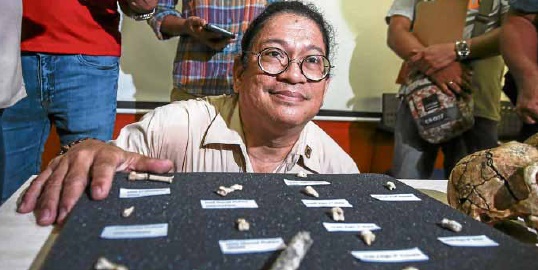More diggings planned on site that yielded fossils

OLDEST FIND Dr. Armand Mijares, who led an international multidisciplinary team, presents the fossils of the newly discovered human species, the Homo luzonensis, from an excavation site inside Callao Cave in Peñablanca, Cagayan, at the University of the Philippines-Diliman.
Archaeologists who discovered fossil bones and teeth of a previously unknown human species that thrived more than 50,000 years ago in the northern part of the country said on Thursday they planned more diggings.
They also called for better protection of the popular limestone cave complex where the remains were unearthed.
Filipino archaeologist Armand Mijares said the discovery of the remains in Callao Cave in Cagayan province made the Philippines an important research ground on human evolution.
The new species is called Homo luzonensis after the main northern island of Luzon, where the remains were dug up starting in 2007.
Six fragments
Beaming with pride, Mijares displayed the six fragments of bones from the feet, hands and thigh, as well as the seven teeth of three individuals from that bygone era at a news conference at the University of the Philippines.
Tests showed two of the fossil fragments had minimum ages of 50,000 years and 67,000 years, according to a study published by the scientific journal Nature.
“This puts the Philippines, our scientific community, in the spotlight,” Mijares said.
“Before, we’re just peripheral in this debate of human evolution.”
Mijares, who led a small team of foreign and local archaeologists behind the rare discovery, said he planned to resume the diggings next year and hoped to find larger fossil bones, artifacts and possibly stone tools used by people in those times.
Oldest to be found in PH
Aside from Callao Cave, human fossils have recently been found in another site in Bulacan province, Mijares said without elaborating.
Another veteran Filipino archaeologist, Eusebio Dizon, said the human remains from Callao were the oldest to be found in the Philippines, predating by thousands of years those discovered in Tabon Cave on the western island of Palawan.
While the archaeological find could attract more scientists, Dizon worried that it could also draw vandals and treasure hunters who could threaten the seven-chamber cave complex, which is a popular tourism destination. An open-air chapel with pews and an altar in the cave complex has become a popular venue for weddings and filmmakers.
“Peñablanca has been a treasure hunting haven of many people,” Dizon said, referring to the Cagayan provincial town where the Callao caves are located.
“Maybe it will reignite their kind of activity, that’s why it needs protection now more than ever.”
Previously unknown
The main exodus of modern humans’ own species from Africa that all of today’s non-African people are descended from took place around 60,000 years ago.
Analysis of the bones from the Callao caves led the study authors to conclude they belonged to a previously unknown member of our “Homo” branch of the human family tree. —AP































